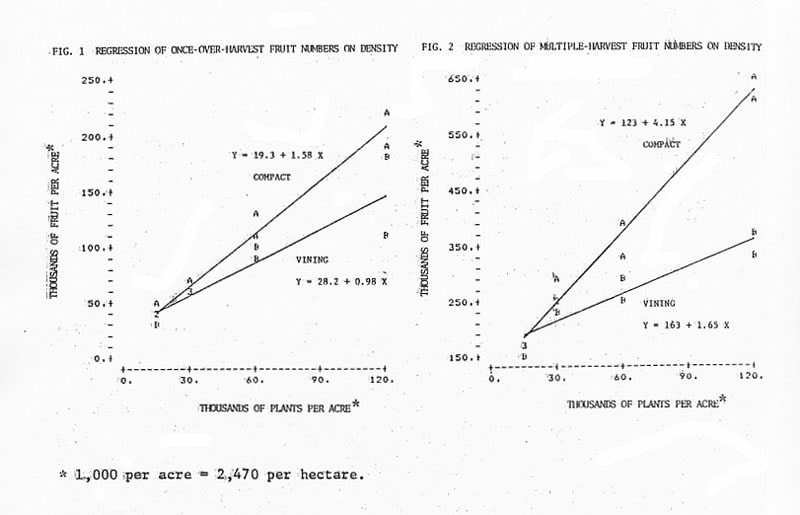Cucurbit Genetics Cooperative Report 5:6-7 (article 3) 1982
M. D. Edwards and R. L. Lower
University of Wisconsin, Madison, WI 53706
The compact plant type of cucumbers has been suggested as an alternative to the standard vining phenotype for use in high density plantings (3). Although the plant architecture appears adapted for efficient utilization of space under intense inter-plant competition and compact genotypes have repeatedly achieved impressive yields in observation plots, their performance relative to standard genotypes has not been adequately tested.
The original compact (PI 308916) has been backcrossed to a number of pickling cucumber inbreds, yielding compact plants with greatly improved horticultural characteristics.
Two sets of predominantly female hybrids were used to compare yields of compact and vining plant types. Each set was comprised of both vining and compact plant types. Isolines of gynoecious inbreds, ‘Gy2’ and ‘Gy14″, were used as female parents and isolines of “Addis’ were used as male parents. Since seed from fruit of compact plants is smaller than that of vining plants and sometimes of poor germinability, both sets of hybrids were made using vining-type seed parents. Female inbreds heterozygous at the compact locus (Cpcp) were pollinated by compact lines. These seed segregated one compact (cpcp): one vining (Cpcp). Plots were over-seeded and thinned to compact plants at the two-leaf stage. This precaution was necessary to assure uniform stand establishment and seedling vigor for comparisons between plant types. The vining hybrids (Cpcp) were produced routinely. The two sets of hybrids were planted at four densities: 37,000, 74,000, 148,000 and 296,000 plants per hectare. The three lowest densities were achieved by varying within-row spacing from 30 cm to 8 cm on 91 cm row centers. The 296,000 plants per ha density consisted of 8 cm within-row spacing on 45 cm row centers. All plots had 30 plants and the middle 25 were harvested. This plot size was recommended by Smith and Lower (4).
Total fruit numbers for the two plant types are graphed against the varying plant densities for first-harvest and multiple-harvest in Figures 1 and 2, respectively. The least-squares simple regression line was fitted through the data points corresponding to each plant type. Responses to increasing density are reasonably well explained by a straight-line model in all cases. Coefficients of determination, R2, for the regression models were 97% and 80% for first harvest fruit numbers of compact and vining plant types, respectively. The corresponding values for a multiple harvest fruit numbers were 97% and 89%. These values reflect a considerably better fit to the straight line model for the compact plant type than for vining isolines.
The difference in multiple-harvest yields of the two plant types at the greatest density may, in part, reflect differences in ease of harvest. Vining plant types at high densities are much more difficult to hand-harvest without inflicting some damage to the plants.
Satisfactory stand establishment from compact seed is the greatest problem facing commercial utilization of compact genotypes (1). This problem was avoided in this study by using seed segregating from a heterozygous (Cpcp) maternal parent. Selection for improved seed quality in compact genotypes is underway. Initial heritability estimates for emergence percentage are large and suggest that improvement for this trait should progress rapidly (2).
Figure 1. (left). Regression of once-over harvest fruit numbers on density; and Figure 2. (right). Regression of multiple-harvest fruit numbers on density.

Literature Cited
- Edwards, M. D. and R. L. Lower. 1980. An analysis of factors related to germinability of seed from compact cucumber plants (Abst.) HortScience 15:108.
- Edwards, M. D. and R. L. Lower. 1981. Selection against a seed abnormality in compact cucumber plants (Abst.) HortScience 16:35.
- Kaufman, C. S. and R. L. Lower. 1976. Inheritance of an extreme dwarf plant type in the cucumber. J. Amer. Soc. Hort. Sci. 101-150-151.
- Smith, O. S. and R. L. Lower. 1978. Field plot techniques for selecting increased once-over harvest yields in pickling cucumbers. J. Amer. Soc. Hort. Sci. 103-92-94.